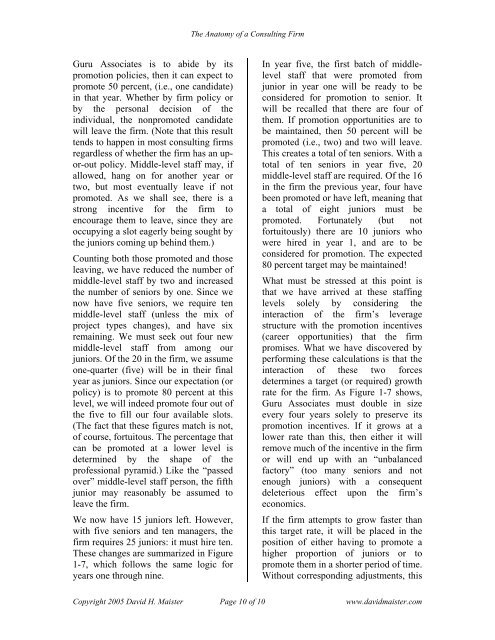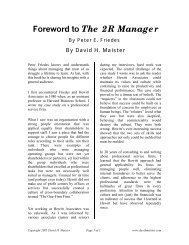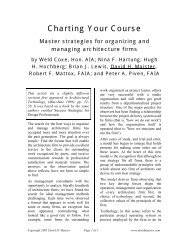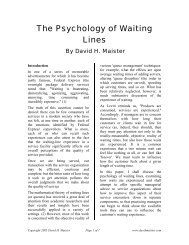pdf version - David Maister
pdf version - David Maister
pdf version - David Maister
Create successful ePaper yourself
Turn your PDF publications into a flip-book with our unique Google optimized e-Paper software.
The Anatomy of a Consulting Firm<br />
Guru Associates is to abide by its<br />
promotion policies, then it can expect to<br />
promote 50 percent, (i.e., one candidate)<br />
in that year. Whether by firm policy or<br />
by the personal decision of the<br />
individual, the nonpromoted candidate<br />
will leave the firm. (Note that this result<br />
tends to happen in most consulting firms<br />
regardless of whether the firm has an upor-out<br />
policy. Middle-level staff may, if<br />
allowed, hang on for another year or<br />
two, but most eventually leave if not<br />
promoted. As we shall see, there is a<br />
strong incentive for the firm to<br />
encourage them to leave, since they are<br />
occupying a slot eagerly being sought by<br />
the juniors coming up behind them.)<br />
Counting both those promoted and those<br />
leaving, we have reduced the number of<br />
middle-level staff by two and increased<br />
the number of seniors by one. Since we<br />
now have five seniors, we require ten<br />
middle-level staff (unless the mix of<br />
project types changes), and have six<br />
remaining. We must seek out four new<br />
middle-level staff from among our<br />
juniors. Of the 20 in the firm, we assume<br />
one-quarter (five) will be in their final<br />
year as juniors. Since our expectation (or<br />
policy) is to promote 80 percent at this<br />
level, we will indeed promote four out of<br />
the five to fill our four available slots.<br />
(The fact that these figures match is not,<br />
of course, fortuitous. The percentage that<br />
can be promoted at a lower level is<br />
determined by the shape of the<br />
professional pyramid.) Like the “passed<br />
over” middle-level staff person, the fifth<br />
junior may reasonably be assumed to<br />
leave the firm.<br />
We now have 15 juniors left. However,<br />
with five seniors and ten managers, the<br />
firm requires 25 juniors: it must hire ten.<br />
These changes are summarized in Figure<br />
1-7, which follows the same logic for<br />
years one through nine.<br />
In year five, the first batch of middlelevel<br />
staff that were promoted from<br />
junior in year one will be ready to be<br />
considered for promotion to senior. It<br />
will be recalled that there are four of<br />
them. If promotion opportunities are to<br />
be maintained, then 50 percent will be<br />
promoted (i.e., two) and two will leave.<br />
This creates a total of ten seniors. With a<br />
total of ten seniors in year five, 20<br />
middle-level staff are required. Of the 16<br />
in the firm the previous year, four have<br />
been promoted or have left, meaning that<br />
a total of eight juniors must be<br />
promoted. Fortunately (but not<br />
fortuitously) there are 10 juniors who<br />
were hired in year 1, and are to be<br />
considered for promotion. The expected<br />
80 percent target may be maintained!<br />
What must be stressed at this point is<br />
that we have arrived at these staffing<br />
levels solely by considering the<br />
interaction of the firm’s leverage<br />
structure with the promotion incentives<br />
(career opportunities) that the firm<br />
promises. What we have discovered by<br />
performing these calculations is that the<br />
interaction of these two forces<br />
determines a target (or required) growth<br />
rate for the firm. As Figure 1-7 shows,<br />
Guru Associates must double in size<br />
every four years solely to preserve its<br />
promotion incentives. If it grows at a<br />
lower rate than this, then either it will<br />
remove much of the incentive in the firm<br />
or will end up with an “unbalanced<br />
factory” (too many seniors and not<br />
enough juniors) with a consequent<br />
deleterious effect upon the firm’s<br />
economics.<br />
If the firm attempts to grow faster than<br />
this target rate, it will be placed in the<br />
position of either having to promote a<br />
higher proportion of juniors or to<br />
promote them in a shorter period of time.<br />
Without corresponding adjustments, this<br />
Copyright 2005 <strong>David</strong> H. <strong>Maister</strong> Page 10 of 10 www.davidmaister.com











